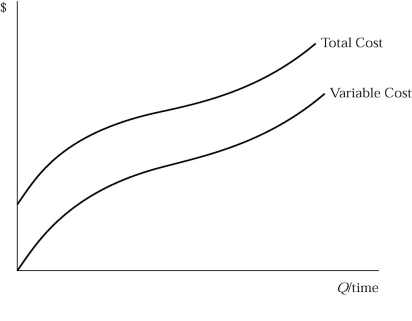A) the vertical distance between Curve 1 and Curve 2 at a given level of output.
B) the vertical sum of Curve 1 and Curve 2 at a given level of output.
C) the vertical sum of Curve 2 and Curve 3 at a given level of output.
D) the vertical distance between Curve 2 and Curve 3 at a given level of output.
F) A) and C)
Correct Answer

verified
Correct Answer
verified
Multiple Choice
 Table 5.4
-Table 5.4 presents the cost schedule for David's Figs. If David produces two figs, David's average variable costs are
Table 5.4
-Table 5.4 presents the cost schedule for David's Figs. If David produces two figs, David's average variable costs are
A) $80.
B) $85.
C) $90.
D) $170.
F) A) and C)
Correct Answer

verified
Correct Answer
verified
True/False
The marginal cost curve always intersects the average total cost curve at the minimum of average total cost.
B) False
Correct Answer

verified
Correct Answer
verified
Multiple Choice
Which of the following is TRUE?
A) ATC = AVC - AFC
B) TVC/Q = TC/Q + TFC/Q
C) ΔTC/ΔQ = ΔAVC/ΔQ
D) ΔTC/ΔQ = MC
F) A) and B)
Correct Answer

verified
Correct Answer
verified
True/False
The long-run marginal cost is the additional cost incurred by the firm when producing one more unit of output, holding the amount of capital constant.
B) False
Correct Answer

verified
Correct Answer
verified
Multiple Choice
Which of the following are included in calculating economic costs?
A) implicit costs
B) explicit costs
C) accounting costs
D) All of the above are correct.
F) All of the above
Correct Answer

verified
Correct Answer
verified
Multiple Choice
The short-run average total cost curve is U-shaped because average fixed costs ________ and average variable costs ________ eventually as quantity produced increases.
A) increase; increase
B) increase; decrease
C) decrease; increase
D) decrease; decrease
F) None of the above
Correct Answer

verified
Correct Answer
verified
Multiple Choice
When the firm increases output and the costs rise disproportionately slower, then the long-run average cost curve is ________ and the firm is experiencing ________.
A) horizontal; constant returns to scale
B) downward sloping; constant returns to scale
C) upward sloping; diseconomies of scale
D) downward sloping; economies of scale
F) B) and D)
Correct Answer

verified
Correct Answer
verified
True/False
Fixed costs are the same in the short run as they are in the long run.
B) False
Correct Answer

verified
Correct Answer
verified
Multiple Choice
 Figure 5.4
-One can tell that Figure 5.4 shows short run costs because
Figure 5.4
-One can tell that Figure 5.4 shows short run costs because
A) the slope of total costs and variable costs are the same.
B) costs are rising.
C) total costs are positive when output is zero implying fixed costs.
D) all of the above.
F) A) and B)
Correct Answer

verified
Correct Answer
verified
Multiple Choice
When the firm increases output and the costs rise proportionately, then the long-run average cost curve is ________ and the firm is experiencing ________.
A) horizontal; constant returns to scale
B) downward sloping; constant returns to scale
C) upward sloping; diseconomies of scale
D) downward sloping; economies of scale
F) A) and B)
Correct Answer

verified
Correct Answer
verified
Showing 201 - 211 of 211
Related Exams